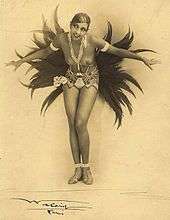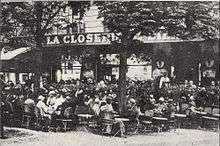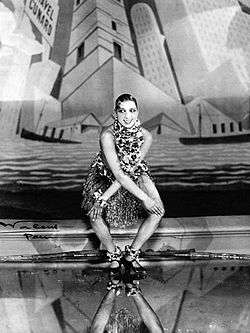France in the 1920s
The '1920s, the period between January 1, 1920 and December 31, 1929 is frequently referred to as the “Roaring Twenties” or the “Jazz Age” in America. While in Europe, the period is sometimes referred to as the “Golden Age Twenties”[1] due to the economic boom following World War I. In France it was referred to as the “années folles” (“Crazy Years”),[2] emphasizing the era’s social, artistic, and cultural dynamism.

Introduction
The Utopia positivist of the 19th century and progressive creed led to individualism. André Gide and Marcel Proust set the tone of this literary trend that exacerbated and increased with the Dada movement of which Tristan Tzara published the original 1918 manifesto. The surrealism of André Breton developed in 1924. The art aouveau extravagance, hit by the war gave way to valuable sketches of Art Deco.
Montmartre and Montparnasse

During the Roaring Twenties, Montparnasse and Montmartre were places that hosted cafes such as Cupola, Dome, Rotunda and Closerie des Lilas or fairs such as Rue de Fleurus.
Montmartre is one of the major centers of these places of encounter. The area has a modern touch with the existence of trumpeters like Arthur Briggs which occurred before American Henry Miller like many other foreign matter, called the Vavin – Raspail – Montparnasse is in his own words "the navel of the world".
In Paris, on the left bank of the Seine, is primarily concerned with the arts and the sciences. Also evidenced the high concentration of artists who settled in the French capital and occupying cabaret spaces Le Boeuf sur le Toit or Montparnasse large breweries. American writers of the "The Lost", i.e. including Scott Fitzgerald, Henry Miller and Ernest Hemingway, met with the exiles who fled the dictatorships in Spain and Yugoslavia. Finally, there was the painters who make up what is referred to as "the School of Paris" and which include among others Lithuanian Soutine, the Italian Modigliani and Russian Chagall.
The surrealist movement
The forefront surreal occupies during the 1920 to the cultural scene by bringing new forms of expression to the poetry with authors like André Breton, Louis Aragon, Paul Eluard or Robert Desnos but also to painting through artists like Max Ernst, Joan Miró, Salvador Dali, Francis Picabia at sculpture with Arp, Germaine Richier and even the film with Luis Buñuel and his famous work The Andalusian Dog René Clair and Cocteau. Now turned to the unspeakable, the avant-garde movement sees its members adhere to a large majority of them in French Communist Party they share the desire to break with the bourgeoisie.
The entertainment world and outside influences
The Roaring Twenties France is largely influenced by diverse cultural practices from abroad and the war has increased the supply of new crops. One of the greatest influences is the rag that is quickly called 'jazz', which is experiencing a dramatic rise and popularity within the city of Paris. This kind of music was brought by the US Army and has been very successful in 1925 on Champs-Élysées with 'the negro Review led successively by Florence Mills, known as "Flossie Mills" and Josephine Baker. Wearing only a loincloth of bananas, the latter suggestive dance with fury at a Charleston tempo – music then unknown in Europe – the interpretation of a painting called Wild Dance . The scandal quickly gives way to general enthusiasm. Josephine quickly generates excitement Parisians for jazz and black music. The Charleston is danced solo, in pairs or in groups, to the rhythms of jazz. It is based on the movements of the body weight from one leg to the other, feet turned inward and knees slightly bent.
Of all the cabarets in fashion, the most famous is called "Le Boeuf sur le Toit" where we see play Jean Wiener, pianist and composer French. Assistant Parisian world these entertainment is only a tiny part of the French population, i.e. elite. Nevertheless it gives the impulse, creates the event.
American Influence
The United States had plenty of influence on the France during the Roaring Twenties. The Charleston, the shimmy, jazz, cabaret and dancing were brought over. Interest in American values, culture, began to characterize the Paris of 1920, magazines and stars of Broadway are purchased at full price and imitated thereafter. But France does not only recover the performances of Overseas because it suits them and even manages to create its own benefits and representations. This is the case for the famous Negro Revue debuted in 1925 at the Champs-Elysees theater, Josephine Baker, a dancer posing naked and plucked, dancing the Charleston and multiplying provocative gestures, with music by Sydney Bechet. Inspired and influenced by the French Colonial Empire, Josephine Baker rises The Madness day in 1926. It also takes café-concerts of hit songs such as La Petite Tonkinoise of Vincent Scotto. The song J'ai deux amours in 1930 enshrined as a star of Parisian life, full featured, which, like the singers do not just dance but comments the tunes of music and gives the comic.
Dance

New rhythms are introduced such as tango. The smoking and the taste for the "negro music," as it is called at the time, push the differing opinions. Paul Guillaume organizes the Champs-Élysées theater 1919 the 'negro Day'. Six years later, the same theater offers the Parisian 'Revue negro'. Rue Blomet, the 'negro ball' attracts aesthetes and curious.
Swedish ballets
The Roaring Twenties were also marked by a renewal of ballet. Thus, it is in 1921 the Swedish Ballet propose The Man and his desire of Paul Claudel with music by Darius Milhaud. They then present The Married to the Eiffel Tower including Jean Cocteau wrote the screenplay. Alas, it does not convince the public. In 1923 is another ballet was born, namely The Creation of the World which Darius Milhaud wrote the music, and Blaise Cendrars scenario. Fernand Léger, who made the costumes, brings out the stage of gigantic animals, birds, insects or totemic gods. The adventure of the Swedish Ballet ends in 1924 with a ballet called Break which involved Erik Satie and Francis Picabia. In the late 1920s is an entire era that is ending, during which the ballets were the occasion of great shows. Do not forget either the importance of trade fairs, those of Princess de Polignac, Madame de Noailles, Count of Beaumont, which were much meeting places and inspiration.
The music hall
This is also the period when the Music Hall permanently replaced café chantant. We go to casino de Paris, the Paris concert and the concert Mayol as will the theater: spectators, attractions and songs are occurring at a rapid pace. Artistic productions are experiencing a meteoric rise. We can give as the best known examples Paris dancing, Cach tone piano, Paris that jazz, My Man and In a wheelchair that gave Maurice Chevalier and Mistinguett an international celebrity. The Little tootsies Valentine go around the world. The American influence, the big show, musicals make the success of the Folies Bergère, the famous "Mad Berge". They indeed inaugurated their cycle with Les Folies raging in 1922.
The operetta
The Operetta also takes a new start on 12 November 1918 with the premiere of Phi-Phi of Henri Christiné and Albert Willemetz. This is a huge success on the bottom of Ancient Greece with many fanciful creations. Indeed, up to a thousand presentations were played in just two years. Another great success is titled In life must not do , the most popular song Dede , created in 1921 to Bouffes-Parisiens again with Maurice Chevalier. Prove talented composers such as Marseille Vincent Scotto but also Maurice Yvain (the composer of 'My Man' ') as well as authors like Sacha Guitry who wrote the libretto of masked Love . In the Olympia at Bobino where the Gaiety Theatre Montparnasse include Marie Dubas and Georgius who inaugurated the Singing Theatre by staging various popular songs. It also has y Damia nicknamed "actress Song" or Yvonne George and his voice of vibrato who gets traditional songs. From 1926, however, the US is competing with the French operetta with titles like 'No, No, Nanette , Rose Mary and Show Boat . The Roaring Twenties are a time stars and varied repertoire operating in various party locations.
Sports

Another form of entertainment in the sports spectacle, has a similar enthusiasm during the Roaring Twenties. Indeed, attendance at sporting venues increased significantly in the years following the war and the Press gives the sporting event a hearing and a growing popularity. The newspapers played major role in promoting sport through dedicated sports pages, giving popularity to the Tour de France, soccer and rugby. Moreover, the practice of this sport, which previously was limited only to affluent backgrounds, now began to extend to the masses. The major sporting event during this decade was Olympic Games in Paris in 1924. 3,092 athletes from 44 countries participated in this sporting event and no fewer than 625,000 spectators attended.
The birth of a popular culture

Along with this elite culture that characterizes the Roaring Twenties, there arise at the same time in Paris, a popular culture. Indeed, the First World War has upset many things, even in the field of song. After four years of nostalgic era of "Belle Époque", new artists are emerging in places fashionable. The Music Hall for example, while attracting artists and intellectuals in search of novelty, also gives in the popular media. There certainly has the exotic big fees journals Moulin Rouge but it is necessary to refer to the same period the beginnings of Maurice Chevalier, ultimate illustration of good French mood through one of his songs, Valentine '. There is also the lead dancer Mistinguett, nicknamed La Miss, who gets successful popular tunes like Always on the grind , I'm fed up . All shows, however, does not reduce as the review.
Economic growth
The Roaring Twenties were also a period of strong economic growth. New products and services in booming markets boost the economy: radio, automobile, aviation oil, electricity. French production of hydropower increases eightfold during the decade.[3] The cheapest electricity favors industrial companies, which in 1928 represent 3 of the top 5 French cap to the Paris stock exchange, where courses are multiplied by 4, 4 of the decade and 5 of the top 10. The 6th is a young innovative company, which is only fifteen Air Liquide, already has a global stature. The manufacturing production index reached in 1928 the level of 139 for a 100 in 1914,[4] with indeed very strong sectoral disparities: it is only 44 for the index shipbuilding 100 to steel and 422 to the automobile.[5] The French overall index fell to 57 in 1919 and 50 in 1921, but already risen to 104 in 1924. It took 6 years to clear the shortage of energy caused by the reconstruction of the northern mines, that the Germans had drowned during the World War I.
Radio
The Radio played a leading role by becoming a preferred vehicle for the new mass culture. Indeed, it has allowed, through the first 78s, to inform more people, especially among the working classes, the stars of the cabaret and music hall. Thus, the radio quickly propels Mistinguett and Maurice Chevalier to the rank of national and international stars, and they quickly become emblems of lifestyle in Paris.
Film
The silent film was powerful and compelling expression of the first three decades of the twentieth century. This visual curiosity, dubbed cinema, which the scientists of the time were predicting little future, and regarded it as a curiosity or a fairground attraction, became the seventh art. Silent film is considered by some as the carefree innocence of years or 7th Art. Max Linder, after being discovered by Charles Pathé.
European film production is then almost completely stopped during World War I as most actors were drafted into the war. When the public takes refuge in theaters to try to forget the horrors of the front, he discovers an unlucky character Charlie Chaplin (A Dog's Life). In Hollywood, the film industry saw massive growth thanks to the sharp decline in production in Europe, it exports its films in increasing quantities. In 1919, the films from the United States account for about 90% of projections in theaters of European cinemas.
Theatrical revival
The Paris of the 1920s, it is also the theater that is essentially represented by four directors and major players i.e. Louis Jouvet, George Pitoëff, Charles Dullin and Gaston Baty. They decide in 1927 to join efforts in creating the "Cartel of Four". However, they have much less success than Sacha Guitry that overcomes him Variety Theatre. There are also parts of Alfred Savoir, comedies of Édouard Bourdet and those of Marcel Pagnol that meet all some success.
Specifically, the theatrical performance was a great success of audience and an undeniable renewal in the 1920, first at the stage performance. Around the "Cartel" develops a creative effort to bring in staging the concerns and aspirations of the time. The change is also reflected in the choice of themes and atmosphere that emerges from the works presented. But parallel to this, the educated public is interested elites increasingly to authors and works that combine classical in the form and the opposition reality / dream at the theatrical atmosphere. Also, the theater Cocteau, the first pieces of Giraudoux as Siegfried in 1928 and the works of Italian Pirandello are the most famous representatives and are very successful. However, all this is classic in the modes of expression chosen and consistent with the taste of the elite.
Roaring Twenties
After the flight of the Stock Exchange during the Roaring Twenties, the 1929 crash to Wall Street announced end of this period of recklessness.[6] Once 1928, the Parisian theater La Cigale farm; in 1929, Olympia and Moulin Rouge suffer the same fate then it was the turn of the theater Eldorado, which was destroyed in 1932. Although production was intended for a wide audience, we note that attendance music halls and other dance halls gradually reduced to the workers and employees of cities. Their world of the song, it is primarily that of the street, the javas and tangos of dances, weddings and banquets and not the Parisian high society. In parallel to this culture of elites is affirmed at the same time in Paris, a popular culture that is increasingly successful and came to dominate in the late 1920s and early 1930s through artists such as Maurice Chevalier or the leader of Mistinguett journals.
The "Roaring Twenties" are characterized both by the desire for inner peace and a society that wants to make the most of life as she can still coming years is uncertain. It is this company that is looking forward to a return of peace and discovers at the same time the benefits of consumption in an effort to eventually extend this maximum internal stability.
References
- ↑ Paul Sann, The Lawless Decade Retrieved 2009-09-03
- ↑ Andrew Lamb (2000). 150 Years of Popular Musical Theatre. Yale U.P. p. 195.
- ↑ "The war economy and its consequences (1914–1929)" by Belisaire
- ↑ Basic "History of twentieth century: 1st and agricultural terminal" by Florence Cattiau Maryse Chabrillat, Annie Constantine, Christian Peltier, Gwen Lepage, in Educagri Press, 2001
- ↑ (Marseille 2001, p. 438)
- ↑ In fact, the crisis will reach Europe that really 1931 and will continue during the 1930
Further reading
- Berstein, Serge and Milza, Pierre, History of France twentieth century, Brussels, Complex, 1995
- Berstein, Serge and Milza, Pierre, History of contemporary Europe, The twentieth century: from 1919 to the present day, Paris Initial Hatier, repr. 2002
- Marseille, Jacques (2001). 1900–2000, a century of Economy. Les Echos. ISBN 2950331068.
- Abbad, Fabrizio, France 1920 ', Paris, Armand Colin, coll. Curriculum, 1993
- Becker, Jean-Jacques and Berstein, Serge, New History of Contemporary France: 12.Victoire and frustrations, 1914–1929 , Paris, Seuil, coll. Points; History, 1990
- Philippe Gilbert and Bernert Guilleminault, The Princes of the Roaring Twenties', Paris, Plon, 1970
- Deslandres and Yvonne Müller, Florence, History of Fashion at twentieth century ', Paris, Éditions Sogomy Art, 1986
- The Roaring Twenties', under the direction of Gilbert Guilleminault, Paris, Denoël, 1956
- Jacqueline Herald, Fashions of a decade: the 1920s, London, BT Betsford Ltd 1991
- Jean-Jacques Leveque, 'The Roaring Twenties. 1918–1939 ', Paris, ACR, 1992
- Tartakowski, Danielle and Willard, Claude, 'Tomorrows that change? The France of the Roaring Twenties and the Popular Front ', Paris, Messidor 1986
- Daniel Gallagher, D'Ernest Hemingway Henry Miller: Myths and Realities of American writers in Paris (1919–1939), L'Harmattan, 2011
- Fabrice Virgili and Danielle Voldman, La Garçonne and Assassin. History of Louise and Paul, deserter transvestite, in the Paris of the Roaring Twenties', Paris, Payot, 2011 (ISBN 9782228906500).
- Michel Collomb, 'Literature Art Deco. The vintage style , Paris, Meridians Klincksieck 1987
- Paul Dietschy and Patrick Clastres, 'Sport, Society and Culture in France nineteenth century to today,' 'Paris, Hachette, coll. Square history, 2006
- Rent, Emmanuelle and Goetschel, Pascale, 'Cultural History of France; Belle Epoque to today, Paris, Armand Colin, coll. Curriculum, 2001
- Jean-Paul Bouillon, Journal of Art Deco, Geneva Skira, 1988
- Delporte, Christian, Mollier, Jean-Yves and Sirinelli, Jean-François 'cultural history of Dictionary of Contemporary France', Paris, PUF collection Quadriga Pocket Dictionaries, 2010